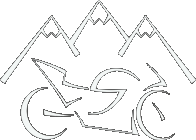Motorcycle 101: Lane positioning
"
When most of us learned to drive, we were taught to drive in the center of our lane. Thatís because most of us learned to drive in a car. That same rule does not apply to motorcycles.
"there are three general lane positions riders can utilize" (Photo: Jiang). CLICK HERE FOR MORE PHOTOS
As rider's, we can, and should, use lane positioning to our benefit. There are three general lane positions rider's can utilize:
As a rider, your lane position should be fluid and change with the circumstances of the moment. There are many reasons to change your lane positioning, but some of the most common reasons are visibility, maneuverability, lane protection and avoiding hazards.
- left of center
- center
- right of center
As discussed in ďBeing Seen is a Riderís Responsibility,Ē it is up to us, as riders, to ensure that we are seen by other traffic. Lane position plays a big part in how visible you are to other drivers. Use your headlight to your advantage; place the beam where it can be seen by other drivers. Change your lane position to avoid blind spots and to avoid riding beside other traffic when possible.
Imagine a blind T-intersection, ahead on your right. Since you canít see the intersecting road, you also canít see traffic that might be turning into your path of travel. If you canít see them, they canít see you. What do you do? A generally accepted rule of thumb would be to slow down and adjust your lane positioning. Perhaps move into lane position 1, as it affords you the widest angle to view the approaching intersection and cross-traffic.
Another scenario would be a wooded, two-lane country road that has one lane in each direction. What are the potential hazards?
Rain presents unique challenges regarding lane position. When it first starts raining, avoid lane position 2, it can be slick as a result of oil leaked from car engines. However, the roadway in positions 1 and 3 is often tire-worn, a condition that can cause water to pool. Here, a rider must use good judgment to make the best lane position choice for the conditions.
- The woods present the hazard of deer or other wildlife. With no approaching traffic, consider lane position 1; it provides the most room in all directions to maneuver.
- Oncoming traffic is another potential hazard. As traffic approaches, consider moving into lane position 2; it affords a space cushion from traffic, yet still allows some distance from the woods to the right.
Potholes, rocks, tree branches, etc also present lane positioning challenges. Riderís should adjust their lane position to avoid these hazards, while making sure to maintain time and space from the other hazards already mentioned.
The slideshow below shows pictures of various roads. The captions review key details of the lane positioning scenarios these roads present. Click here to view the slideshow."







 Reply With Quote
Reply With Quote